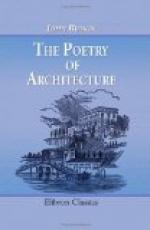136. All this, however, has very little effect in introducing the eye to the villa itself, owing to the general want of inequality of level in the ground, so that the main building becomes an independent feature, instead of forming the apex of a mass of various architecture. Consequently, the weight of form which in the former case it might, and even ought to, possess, would here be cumbrous, ugly, and improper; and accordingly we find it got rid of. This is done, first by the addition of the square tower, a feature which is not allowed to break in upon the symmetry of buildings of high architectural pretensions; but is immediately introduced, whenever less richness of detail, or variety of approach, demands or admits of irregularity of form. It is a constant and most important feature in Italian landscape; sometimes high and apparently detached, as when it belongs to sacred edifices; sometimes low and strong, united with the mass of the fortress, or varying the form of the villa. It is always simple in its design, flat-roofed, its corners being turned by very slightly projecting pilasters, which are carried up the whole height of the tower, whatever it may be, without any regard to proportion, terminating in two arches on each side, in the villa most frequently filled up, though their curve is still distinguished by darker tint and slight relief. Two black holes on each side, near the top, are very often the only entrances by which light or sun can penetrate. These are seldom actually large, always proportionably small, and destitute of ornament or relief.
137. The forms of the villas to which these towers are attached are straggling, and varied by many crossing masses; but the great principle of simplicity is always kept in view; everything is square, and terminated by parallel lines; no tall chimneys, no conical roofs, no fantastic ornaments are ever admitted: the arch alone is allowed to relieve the stiffness of the general effect. This is introduced frequently, but not in the windows, which are either squares or double squares, at great distances from each other, set deeply into the walls and only adorned with broad flat borders. Where more light is required they are set moderately close, and protected by an outer line of arches, deep enough to keep the noonday sun from entering the rooms. These lines of arches cast soft shadows along the bright fronts, and are otherwise of great value. Their effect is pretty well seen in fig. 10; a piece which, while it has no distinguished beauty is yet pleasing by its entire simplicity; and peculiarly so, when we know that simplicity to have been chosen (some say, built) for its last and lonely habitation, by a mind of softest passion as of purest thought; and to have sheltered its silent old age among the blue and quiet hills, till it passed away like a deep lost melody from the earth, leaving a light of peace about the gray tomb at which the steps of those who pass by always falter, and around this deserted, and decaying, and calm habitation of the thoughts of the departed; Petrarch’s, at Arqua. A more familiar instance of the application of these arches is the Villa of Mecaenas at Tivoli, though it is improperly styled a villa, being pretty well known to have been nothing but stables.




